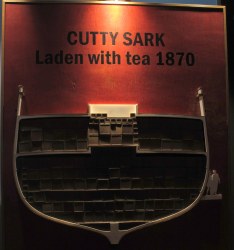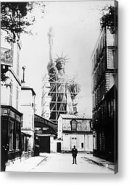The Adventures of Mark Twain (1985) is an 80s-tastic way to Learn About this Great American Writer

I was born in the 1980s, but a little too late to really remember its pitfalls (like huge hair and shoulder pads) or its triumphs (the advent of the music video, and of course, Steampunk) first hand. Luckily for us, this was a time when tons of weird, wonderful and sometimes experimental television and movies were being made, which captured some of the essence of that era. The 1970s and 80s saw a revival of a film technique that was pioneered by Thomas Edison’s manufacturing company in 1908: clay-animation. You can see their film, A Sculptor’s Nightmare, here.
 The very first stop-motion film of all time, which employed moving toys, was made in 1897. Samuel Langhorn Clemens, better known by his pen name, Mark Twain, lived until 1910, so it is entirely possible that he saw the first clay-animation film and probable that he saw earlier stop-motion films as well.
The very first stop-motion film of all time, which employed moving toys, was made in 1897. Samuel Langhorn Clemens, better known by his pen name, Mark Twain, lived until 1910, so it is entirely possible that he saw the first clay-animation film and probable that he saw earlier stop-motion films as well.
 The Adventures of Mark Twain was made in 1985 and is a trippy clay-anmation sojourn through the works of Mark Twain. There is a little bit of biographical information, but mostly it is a chance to showcase his contributions to literature. The viewer is swept away along on an airship adventure along with some of Twain’s best-known characters, Huck Finn, Tom Sawyer and Becky Thatcher. Twain was born near the passage of Halley’s Comet in 1835, and always said he believed he would leave this world again the next time it passed in 1910 (he died the day after it returned), so the film revolves around him trying to keep his “appointment” and visiting some of his greatest works along the way.
The Adventures of Mark Twain was made in 1985 and is a trippy clay-anmation sojourn through the works of Mark Twain. There is a little bit of biographical information, but mostly it is a chance to showcase his contributions to literature. The viewer is swept away along on an airship adventure along with some of Twain’s best-known characters, Huck Finn, Tom Sawyer and Becky Thatcher. Twain was born near the passage of Halley’s Comet in 1835, and always said he believed he would leave this world again the next time it passed in 1910 (he died the day after it returned), so the film revolves around him trying to keep his “appointment” and visiting some of his greatest works along the way.
 Though it may seem morbid that he is racing to his own death, the film is wonderful combination of stunning visuals, abstraction and humor, which totally downplays the seemingly morbid plot line. Though I should warn you that even though this is an animated film, and so you may be thinking it was made for kids, the depiction of “The Mysterious Stranger” is pretty terrifying. Adults would get much more out of this movie than kids, especially if they have read any Twain at all.
Though it may seem morbid that he is racing to his own death, the film is wonderful combination of stunning visuals, abstraction and humor, which totally downplays the seemingly morbid plot line. Though I should warn you that even though this is an animated film, and so you may be thinking it was made for kids, the depiction of “The Mysterious Stranger” is pretty terrifying. Adults would get much more out of this movie than kids, especially if they have read any Twain at all.
 I thoroughly enjoyed this film, which came out on DVD in 2006. When it was originally released in 1985 it had a very limited run, so I wouldn’t be surprised if few people even knows it exists.
I thoroughly enjoyed this film, which came out on DVD in 2006. When it was originally released in 1985 it had a very limited run, so I wouldn’t be surprised if few people even knows it exists.
Saville Row

In the early days after its construction in the 1730’s, “Saville Street” was home to officers of the British military. The next century it became the first home of the Geographical Society of London (today known as the Royal Geographical Society, RGS), which was granted its Royal Charter under Queen Victoria. The RGS was responsible for financing such notable expeditions as David Livingstone’s sojourn into Africa, which lead to the discovery of the Nile’s source (named Lake Victoria) by Sir Richard Burton and John Speke. The RGS moved its headquarters in 1913, which was also the same year that women were first allowed to join.
During the Victorian era, Saville Row become strongly associated with the tailoring trade, and today the street is lined with stores selling natty men’s fashion. On a literary note, Jules Verne gives Phileas Fogg, the hero of Around the World in 80 Days, the address of No. 7 Saville Row. There isn’t a lot to see today, so for me, the most compelling thing about visiting this area ended up being the nearby Burlington Arcade.
“Heterosexual” is Yet Another Thing Invented in the Victorian Era

I recently ran across and article by Thomas Rogers in Salon magazine from 2012 that was an interview with Hanne Blank, the author of Straight: A Surprisingly Short History of Heterosexuality. I knew that “homosexual” was a relatively new word in our vocabulary, but I had never really thought about its counterpart, “heterosexual.” The article is all about the history of this word and the baggage that got attached to it by psychiatrists and evolutionary scientists in the early days of their crafts, aka the time period that much of Steampunk occupies. I haven’t had a chance to read Blank’s book, but I wanted to pass on a summary of the article.
The terms “homosexual” and “heterosexual” appear at the same time. According to Blank’s research, both were the invention of an Austro-Hungarian journalist writing about a piece of Prussian legislation that made certain acts between same-sex people illegal. He was trying to create two categories that were on equal footing as a way to address the hypocrisy of making some acts legal for some people, which the same acts were criminalized for others.
This was sometime in the mid-19th century, but the terminology didn’t really take off until closer to the end of the century. Thanks to the work of Sigmund Schlomo Freud (who is and will always be “Ziggy F” to me) and his acolytes during the 1880’s and 1890’s, people were suddenly being diagnosed with all kinds of crazy stuff. In regards to the term “heterosexual” Blank said it perfectly in the interview:
Psychiatry is responsible for creating the heterosexual in largely the same way that it is responsible for creating the various categories of sexual deviance that we are familiar with and recognize and define ourselves in opposition to. The period lasting from the late Victorian era to the first 20 or 30 years of the 20th century was a time of tremendous socioeconomic change, and people desperately wanted to give themselves a valid identity in this new world order. One of the ways people did that was establish themselves as sexually normative.
Ziggy F’s theories are largely a source of giggles nowadays, but when they were shiny and new they carried a lot of weight in society. The Zigster was more or less a narcissist and viewed himself to be the apex of human psychological development. Basically, if you followed his formula for ‘health’ what you arrived at was a heterosexual (and probably white) male. (Women were already hopeless cases according the F-man. He believed we were all born longing for a penis and it just went downhill from there.)
So now let’s bring romance into the equation. Keep in mind that for much of human history, “love” and “marriage” had very little to do with one another. Marriage was more often than not an alliance between families, more akin to a business arrangement than anything based on desire, and procreation was considered part of the bargain. You didn’t have sex with your partner because you WANTED to, you did it as part of your marital duties. Of course, if you desired your partner in addition to meeting the requirements of your contract then bully for you, but being attracted to your partner was not necessary to pass on the family name.
As I am sure you are aware, society at large was undergoing many changes during the Victorian period, and this is probably a big reason you find Steampunk compelling (I know this is true for me!). Cities were drawing people out of the countryside and crushing them together in close quarters. Women and people of color started to demand the right to vote. Workers began to demand better conditions and wages. And anarchists challenged the very fabric of society with their views. And when times get tough, people fall back on the simplest of relationships, the binary. Breaking a complex world into sets of two categories is much easier than investigating the gray area that lies between black and white. As Blank put it, they started to find an identity that proved their validity in a rapidly changing world.
Also, as people started to demand to be allowed to determine their own futures, they had to stop and think for the first time what it was they WANTED from life. So the question of desire and the shift to seeking out a partner because of your feelings of attraction and love came to the forefront of the discussion for the first time.
Blank’s book goes into far more detail and continues to unpack the term “heterosexual” and its relationship to gay, trans and other terminology and notions into to the present day, but I will leave off here. If you would like more information you can read the full interview, or buy the book.
The Cutty Sark and the English Tea Trade

 It is common knowledge that the Brits love their tea, but it is less common knowledge how this love affair all began. If you are looking for a fun way to explore that history, you should try visiting the good ship Cutty Sark near the waterfront in Greenwich.
It is common knowledge that the Brits love their tea, but it is less common knowledge how this love affair all began. If you are looking for a fun way to explore that history, you should try visiting the good ship Cutty Sark near the waterfront in Greenwich.
The ship itself wasn’t built until 1869, but tea first came to the UK two centuries earlier. Here is a timeline from the Cutty Sark’s exhibits.
 In its heyday, The Cutty Sark was one of the most impressive vessels on the sea, and especially well-suited for transporting tea. The copper hull was not only beautiful, but was especially good at keeping sea water out of the cargo hold. It also had an amazing carrying capacity and was one of the fastest ships on the water.
In its heyday, The Cutty Sark was one of the most impressive vessels on the sea, and especially well-suited for transporting tea. The copper hull was not only beautiful, but was especially good at keeping sea water out of the cargo hold. It also had an amazing carrying capacity and was one of the fastest ships on the water.
In fact, it engaged in a historic race in 1872 against another transport called The Thermopylae. Both ships left Shanghai at the same time, and the Cutty Sark took an early lead. Unfortunately, she lost her rudder and had to stop for repairs. The Thermopylae ended up making it to England a full week before The Cutty Sark. This was the only time that both ships left from the same port at the same time, but the Cutty Sark later set a record for reaching Sydney in just 73 days.
I loved visiting the exhibits on the inside, especially the first floor where the interior and the displays were made out of tea crates. There is another gallery the next floor up that has interactive features and videos to help you get into the mindset of a sailor on the ship over its long history. I was also lucky enough to have the perfect weather to explore the deck, which has been restored to its former and shiny glory.
More Clockwork Treasures from the Royal Observatory

One of the biggest leaps forward in human history was when we started to use the movements of the stars, sun and moon to tell time. And as far as we know, we are the only animals that do. You may find yourself noticing a slight bend in space and time as you approach the Observatory, or perhaps it was just the long trek up the steep hill that made the minutes seem like hours!
Eventually, humans invented machines to keep track of the units in which we divided the world and some would argue that these machines now rule our lives. But no matter how you feel about clocks and schedules, you can’t deny the ingenuity and skill that has gone into inventing, improving and crafting timepieces. And if you are a steampunk fan, you probably can’t get enough of the shiny gears and complex mechanisms that had their heyday in the 18th and 19th centuries.
 The Royal Observatory (also called the Greenwich Observatory) is the home of the Prime Meridian line, and the site for calculating Greenwich Mean Time since the 19th Century. This means that even more than anywhere else it has been imperative that they keep accurate time, and they celebrate this history in their exhibits. After I was done at the Longitude Punk’d galleries, I took a stroll through the rest of the Observatory and I found amazing machines for seeing the stars and terrific time-keepers. I had accidentally used up a lot of my battery during the first half of the day at Longitude Punk’d and the Cutty Sark, but even with a full battery I don’t know if I would have been able to fit all of the beautiful pocket watches, nautical devices and astrolabes onto my memory card anyway!
The Royal Observatory (also called the Greenwich Observatory) is the home of the Prime Meridian line, and the site for calculating Greenwich Mean Time since the 19th Century. This means that even more than anywhere else it has been imperative that they keep accurate time, and they celebrate this history in their exhibits. After I was done at the Longitude Punk’d galleries, I took a stroll through the rest of the Observatory and I found amazing machines for seeing the stars and terrific time-keepers. I had accidentally used up a lot of my battery during the first half of the day at Longitude Punk’d and the Cutty Sark, but even with a full battery I don’t know if I would have been able to fit all of the beautiful pocket watches, nautical devices and astrolabes onto my memory card anyway!
Here’s a sampling of what there is to see in the history galleries.
In addition to the Observatory, you can also visit the Astronomy Center for free. There are lots of exhibits there for amateur astronomers, as well as London’s only planetarium.
Have you ever visited the Royal Observatory or Astronomy Center? Did you have a favorite part?

































































































































